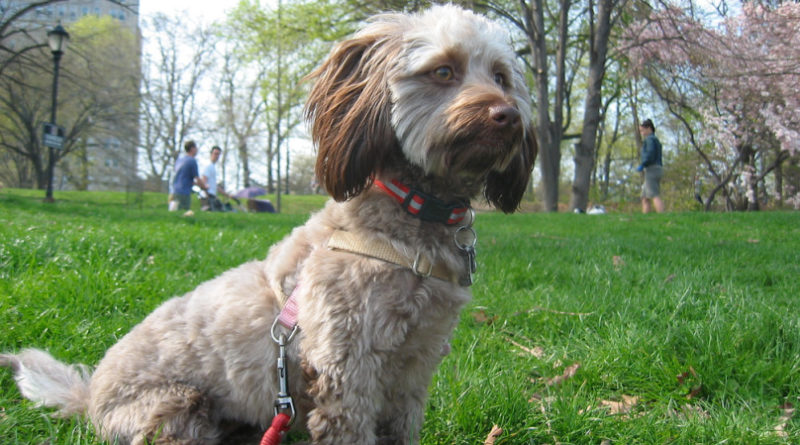Doxiepoo Dog Breed, Temperament, Diet and Training
If you like the combination of a sausage dog and a poodle, get yourself a Doxiepoo. We will explain what this little creature is, and its needs in the rest of this article.
The Doxiepoo is a charming fellow that will bring life to your home. To make sure that it gives its best, use this guide wisely.

What is a Doxiepoo?
So, what is in the Doxiepoo crossbreed package?
The Doxiepoo is a cross between a Daschund and a Poodle. The Daschund is short-legged and long-bodied. It’s known for its low-slung body and is known as the Sausage dog for obvious reasons. Hence, many Doxiepoos fit the definition of the phrase ‘hot dog’.
Kennel Clubs have classified the poodle as one of the formal dog breeds, owing to its elegant appearance. The poodle haircut is probably one of the best-known hairdos for dogs. It allows you to recognise the poodle straightaway.
Consequently, crossing the two breeds results in an intriguing mix. As with many cross breeds, you won’t know what puppy you’re going to get when it comes to looks and personality.
Doxiepoo History
The Doxiepoo began as and is today a cross between a Dachshund and Toy Poodle. Breeders started developing it in the early 21st century as a companion dog. They began doing so because designer dogs had better health than purebreds. These days, they cross Doxiepoos with other Doxiepoos. We don’t know much about its history, but we do know about its parents’.
1. The Dachshund
The Doxiepoo’s first parent is the Dachshund, a hound which German farmers used to catch badgers and other rodents which lived in burrows. Farmers and hunters in the United States relied on it to track deer and capture prairie dogs.

Some theorists say that this dog came from ancient Egypt, whatever many engravings of short, four-legged hunting dogs. The modern Dachsund, however, is the pride of German breeders.
It earned the German name Dachs Kreiger or badger-hunting dog. It arrived in European courts in the 18th century. Queen Victoria of England grew fond of the breed.
The short, smooth-haired Dachshund was the first to become famous. Historians believe that it was a cross between a pointer, a Pinscher, and the Bracke, a type of bloodhound.
The Dachshund grew famous for its curved tail, which characterises many burrowing dogs. Hunters pulled on it when the dog got stuck in a hole.
People began to breed Dachshunds of different colours. Dappled dachshunds, many of which have eye conditions, became common by 1885.
Then, there’s the long-haired Dachshund. Occasionally, some dams would produce long-haired puppies. A theory emerged that they resulted because of crossing Daschunds with Spaniels. Breeders prefer them for developing Doxiepoos.
2. The Poodle
It’s safe to say that the Doxiepoo gets its intelligence from its other parent, the Poodle.
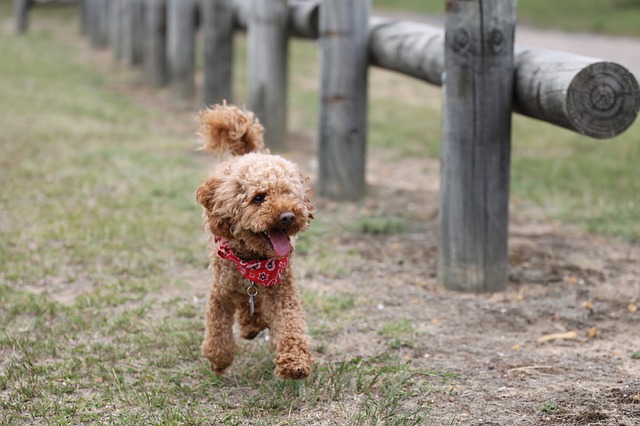
Ranked as the world’s second most intelligent dog after the Border Collie, the Poodle isn’t only smart – it also excels in agility activities. Not surprisingly, it can herd and track livestock. Farmers first developed it for this purpose.
Like the Dachshund, the Poodle comes from Germany. Breeders gave it the name Pudel, which means ‘to splash around’. It may have been a cross between the Hungarian Water Dog and the Barbet.
This elegant, active, bright dog was famous. In fact, people knew about it even before it came to Europe. The artist, Albrecht Durer drew it, as did Francisco Goya.
The Poodle contributes to many dog breeds today. Of course, one of them is the Doxiepoo. Others include the Boxerdoodle ( a cross between a Boxer and a Poodle), the Goldendoodle ( a cross between a Golden Retriever and a Poodle), and the Labradoodle ( a cross between a Labrador Retriever and a Poodle).
Doxiapoo Appearance
Welcoming a crossbreed home is like unwrapping a Christmas gift. As Forrest Gump said, you never know what you’re going to get. The appearance of crossbreeds vary, and the Doxiepoo is no exception. Its look depends on which parent it takes after.
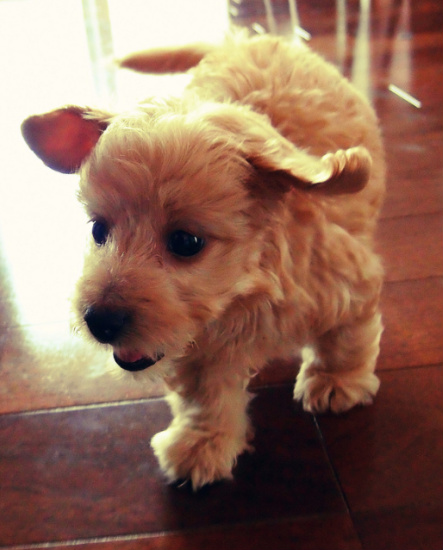
This dog is small to medium-sized because the weights and sizes of small and miniature poodles vary. Breeders don’t use the standard poodle to develop the doxiepoo because it’s too large.
Like its parents, the Doxiepoo has a round head. It has a pointed muzzle and a rounded nose. Its eyes, like its parents’, are expressive. They are either brown or Hazel.
Since it’s a hybrid, it may have a multicoloured coat. Color possibilities are black, white, red, tan, or a mix of all. The hairs are medium length and dense. Like the poodle’s, they are wavy.
The Doxiepoo’s body, owing to its Dachshund heritage, is long. In essence, it looks like a curly sausage. Like the Dachshund, it has a curved tail. It has floppy ears like both its parents.
The Doxiepoo Temperament
So, what kind of personality does this little hybrid have? Its parents’ tempers tell us that it’s interesting.
A Doxiepoo puppy, at its worst, will have the negative traits of both its parents. At best, it will be gentle, intelligent, and people-friendly.
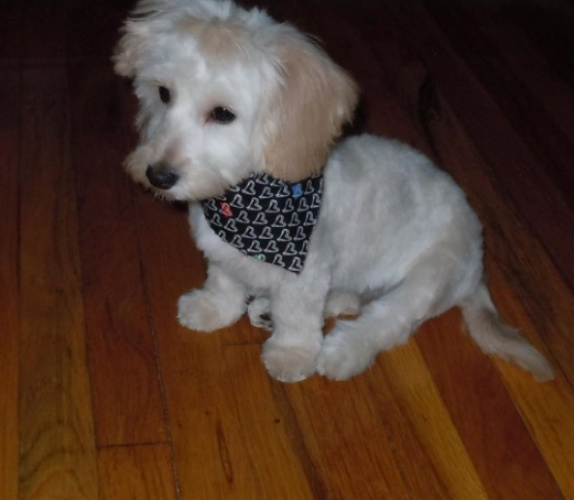
The Dachshund is renowned for its stubborn streak. You can expect the little Doxiepoo to have one as well. Don’t expect it to come to you right away when called. House training it will also take some patience. Use the reward and reinforcement method when dealing with the Doxiepoo ( or any other dog).
Thankfully, the Poodle’s sociability and cleverness offset this obstinate tendency. What this means is that the Doxiepoo may take some time to toe the line but will do so in the best way.
Like the Dachshund, the little Doxiepoo is active, alert, and full of fun. It becomes bored quickly, so you won’t want to leave it to its devices for too long. Be prepared for some chaos if you do.
Get ready to deal with some separation anxiety. The Dachshund believes that sleeping on the bed with its owner is within the Doggy Bill of Rights. It invokes this amendment whenever it can. Recommendations for dealing with such behaviour is in a later part of this article.
The Doxiepoo is a companion dog which loves people. Ideally, it should stay indoors. If you leave your dog in your backyard, give it a spot where it can dig. Expect a mess in your garden when you come home otherwise. You can, at least, restrict the mess the dog creates to a fixed spot.
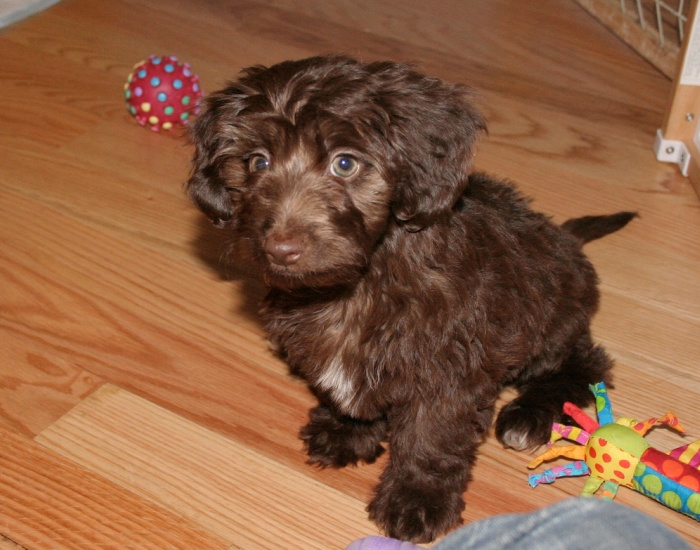
The Doxiepoo has a few annoying habits like barking, chewing, and jumping. However, they are typical of every dog. Address them quickly so that it can become a beloved family member. Advice on overcoming this is in another section of this article.
Like both its parents, the Doxiepoo is great with other people and pets. It may be a little reserved at first ( the Dachshund is famous for selecting the people and animal friends it mixes with) but will enjoy your companionship once it gets used to you.
Both the Poodle and Dachshund are courageous dogs, so expect your little Doxiepoo to have a lot of guts. It should have no fear asserting itself with the people and animals it meets, should it feel bullied.
The Doxiepoo, like it’s Poodle parent, has excellent instincts. It will inform you when there’s someone at your door. This fellow knows what to do and when to do it.
Addressing Doxiepoo Housebreaking Problems
One thing every Dachshund owner knows is that these little dogs are a task to housebreak. One can expect that the Doxiepoo may not be much different.
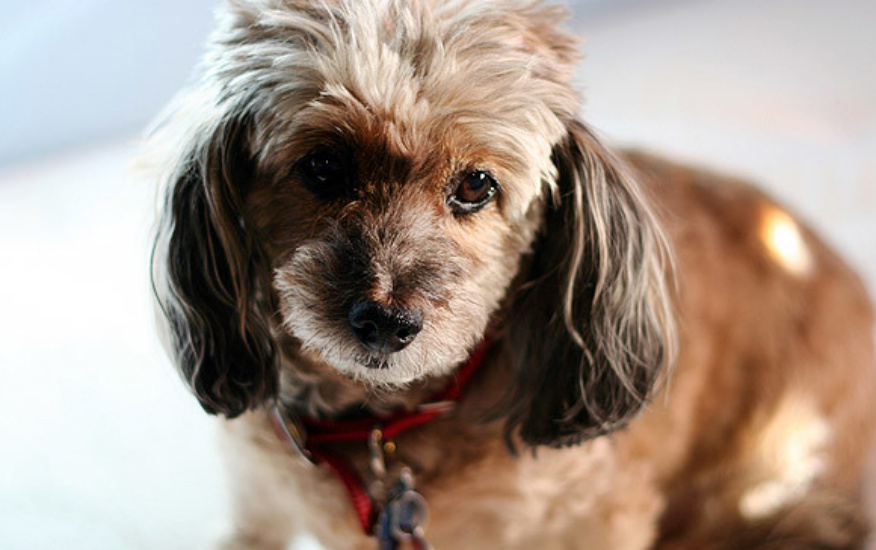
Note, though, that this isn’t because of a lack of intelligence. This dog just does what it wants. Hence, you’d have to show it who’s boss. Here are some tips on housebreaking this stubborn fellow.
1. Potty Pads
You may want to use potty pads, depending on your needs. Potty pads are useful in apartments, where you’d expect your dog to relieve itself indoors. The reason for this, of course, is a lack of space.
Place a potty pad where you want your dog to relieve itself. It will keep going to the area when it gets used to the smell.
2. Newspaper
You will need to put your Doxiepoo puppy in a confined area for this to be successful.
Lay newspaper out in the area where you want your dog to go. Again, let it get used to the odour. It will start to relieve itself in the area.
You will want to start narrowing the area down. Slowly remove the newspapers until enough of them are in the exact spot you want it to ease itself. Your dog will understand that this is his ‘ restroom’.
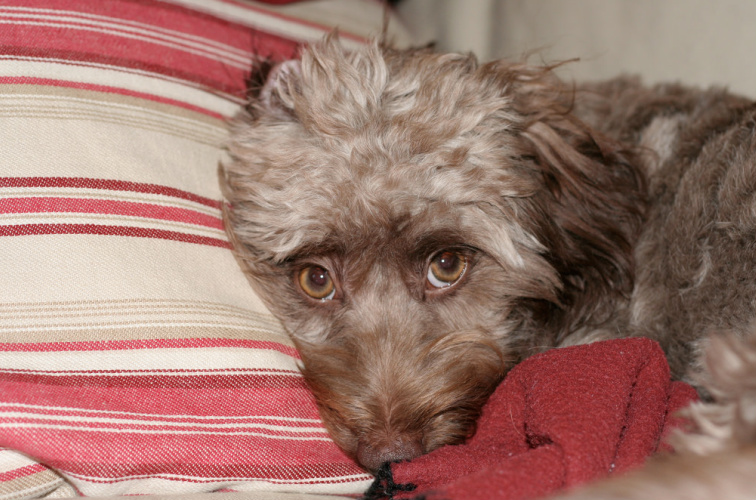
3. Crate training
Some people don’t relish the idea of using a crate because it seems like imprisonment. But it is a safe and necessary tool.
Make sure that the crate is of the right size for your dog. It should be able to sit, stand, and turn around in it. Dogs are clean creatures; they won’t defecate in places where they are supposed to rest. If the cage is too big, it may choose a corner to pee and poo. And of course, you won’t want that.
To encourage it to use the crate, leave it open. Put a treat in it. A bone or dog biscuit helps the dog associate it with safety. Your dog will go into it to get the treat, and eventually, use it of its own accord.
This process may take a while. Once it gets used to the crate, it will start to indicate when it needs to go out of the cage to pee. Let it out when it starts to get restless.
4. Prepare a routine
Set a schedule for your puppy to pee and poo. Puppies will usually go about half an hour after they eat. Your dog will relieve itself at the time you want when it becomes accustomed to the schedule.
5. Take your dog out
Don’t forget to let your dog relieve itself outside. Your Doxiepoo will usually need to go after a meal, nap, or when something exciting happens.
Addressing Annoying Doxiepoo Habits
A sad truth we must acknowledge is that dogs end up in shelters because of their behavioural problems. Animals, like children, need guidance; their owners bear the responsibility of keeping them in line.
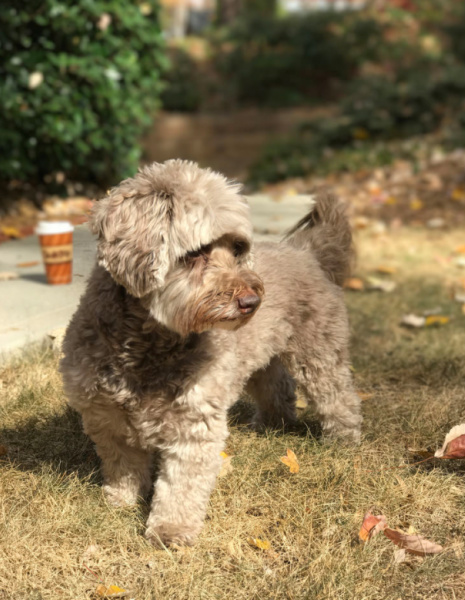
The Doxiepoo, like other dogs, needs firm direction. Overcoming its annoying habits will allow you to establish rapport with it.
Furthermore, your dog will develop life skills. Your Doxiepoo is unlikely to chew or bark excessively. It will also be able to socialise with other people and dogs. Dealing with problem behaviours makes your dogs an excellent companion.
So, what are the challenging behaviours you have to overcome, and how?
1. Barking
Barking is a concern among dog owners. If it’s uncontrolled, it will annoy you as well as your neighbours.
To keep your dog in check, find out what makes it bark. Your pet may be seeking attention or food. If your Doxiepoo barks to get you to do what it wants (e.g. give it a treat), it’s wisest to ignore it. If the barking is because of unacceptable behaviour (e.g. constant treating or attention) redirect it to more acceptable behaviour, like using its chew toy.
2. Jumping
Dog lovers don’t mind an excited puppy jumping on them in greeting. After all, the dog’s just trying to be friendly.
The jumping is cute but could frighten a child or hurt him. Your dog may also leave painful scratches behind.
To overcome it, ignore it when it jumps. Use the word, ‘no’. Give it a reward or affection only when it responds to the command.
3. Chasing
Your dog risks injuring itself if it chases cars, pedestrians, or cyclists. It may even harm others without intention. So, breaking this habit is necessary.
Make sure that your dog understands how to sit, stay, and come. Give it chances to run around in your backyard. Also, microchipping it will give you peace of mind.
4. Chewing
Every dog has a problem with chewing. To discourage the habit, make sure that it has safe toys to chew.
Dogs chew because they feel worried or bored. If you catch it nipping something it isn’t supposed to, replace the item with one of its chew toys at once.
5. Begging
Do you feel as if you have to fit an extra seat at the dining table because your dog’s always there when you eat? Don’t.
Acknowledging begging behaviour, even by saying no, tells your dog that it’s acceptable. To limit it, ignore your dog when it asks for food. Feed it at the same time you eat.
6. Nipping
Dogs nip us to get our attention or to indicate that they want to play. You can stop this by yelping when it nibbles you. Then, refuse to interact with your dog for at least 10 seconds. Repeat this until your dog understand that it isn’t supposed to show the behaviour.
7. Aggression
Your Doxiepoo may show aggression to people and other dogs. This behaviour is both embarrassing and dangerous.
To overcome it, bring your dog on daily walks. Take it to dog runs, where it can interact with other people and their pets. Remove it from any situation where aggression may show itself.
Doxiepoo Breeding Tips
You love dogs, especially the adorable Doxiepoo. You’ll want your Doxiepoo puppy soccer team, and why not?
If you’re considering welcoming Doxiepoo pups into your home, you’ll need some advice. Here are a few tips about the breeding process.
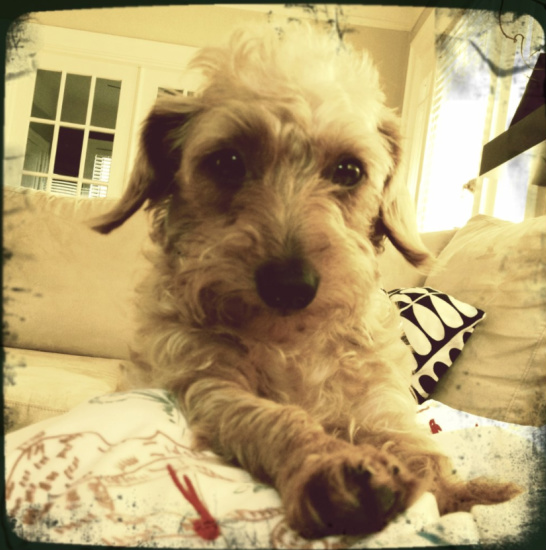
1. It all begins with education
First of all, educate yourself about the Doxiepoo. If you are breeding purebred puppies, you need to find out about Kennel Club standards for different dog breeds.
However, this is not necessary with the Doxiepoo, which isn’t a recognised breed. But it’s still essential to do a little research. Begin by reading guides like this one, which shares details about its history, housebreaking, nutrition, training, and grooming needs.
2. Don’t rush into the process
Don’t be in a hurry to breed your female. Let it grow up, and make sure that it’s adequately vaccinated. Your vet will tell you if she is in good enough health to breed.
3. Search for a recognised breeder’s help.
Ask for a qualified breeder’s opinion. Get recommendations from people who have bought puppies or from dog trade shows. Pet shops may be able to drop a few names as well.
Then, find out if the breeder has those qualifications. Inspect his premises, which should be clean. There should be enough space for a dam to whelp her pups. The breeder should have a certificate from a locally or internationally recognised Kennel Club which allows him to breed dogs.
4. Inspect the stud and dam
Choose the dogs that you want to mate carefully. Both the stud and dam should be healthy.
Look at that physique, temperament, and responsiveness. Don’t breed dogs that are apparently in poor health, as their pups will be as well. You won’t want to mate dogs that are too timid or dominant because their progeny will take on these behaviours.
Always have more than one pair of dogs in mind, lest there are changes along the way.
5. Prepare contracts
Once you have chosen your dogs, draft contractual agreements that state obligations regarding the number of puppies the stud and dam owners can have. The contract should also note details of the sale of these puppies, vaccinations, and care.
6. Begin advertising
Start an advertising campaign way ahead of the planned breeding.
You may wish to design a website that allows people to apply for one of the puppies. There are also social media options, such as Facebook or Twitter.
7. Prepare the female for breeding
Give your female a progesterone test to determine if she’s ready to mate. It should have high progesterone levels.
Feed the female with top quality dog food and get her ready to whelp. Get a whelping box that has enough space for her and her puppies. Have plenty of towels on hand.
Get whelping supplies ready. These should include a thermometer, syringes, and disinfectant.
8. Decide on an ultrasound
Once you have bred your female, decide on whether you want an ultrasound to confirm its pregnancy. Ultrasounds and x-rays should tell you how many puppies to expect.
9. Get an experienced dog lover to assist you
Have someone on hand to help you when the female is ready to give birth. Ideally, this person should be able to come when called.
10. Have cash and emergency numbers ready
The unexpected may happen during the birthing process. You may need to buy supplies at short notice, so have money ready. Note emergency numbers ( e.g. your vet) so that there’s help if needed.
Human food you can give your Doxiepoo
Let’s face it. Dog food is expensive. You may want to feed your little Doxiepoo human food but aren’t sure which ones it can take. Here are a few foods that you and your dog will love.

1. Peanut Butter
Simple as it sounds, peanut butter makes a scrumptious yet healthy treat for your pet. It prevents your dog from begging at the table because it lasts so long. Get a brand that unsalted and has no sugar substitutes.
2. Chicken
Fresh, whole chicken ensures holistic well-being. It’s good for humans and dogs.
You can prepare chicken meals in a variety of ways. Add vegetables or mix it with a little cheese (see below). Remember not to give your dog the bones as the fragments are dangerous.
3. Cheese
Cheese is an excellent option for dogs which are not lactose intolerant. It boosts bone development because it’s high in protein and calcium. Cheese sticks make the perfect treat for a bored Doxiepoo.
4. Carrots
Carrots are a low-calorie food. They are also high in vitamin A and fibre. A tough carrot stick will occupy your dog for hours.
Carrots, which have a low-calorie content, are the perfect treat to give your Doxiepoo if it’s overweight.They strengthen your dog’s teeth as well.
5. Yogurt
Does your Doxiepoo often suffer from Irritable Bowel Syndrome? Yogurt, a source of healthy probiotics, will manage its digestive problems.
Note, however, that you should choose your yoghurt carefully. Make sure that it has active cultures and has no added sugar. There shouldn’t be any flavour either.
6. Pumpkin
Don’t forget to include your Doxiepoo in your Halloween celebrations. At the very least, it can help you finish all that leftover pumpkin.
Pumpkin, without any additives, benefits dogs with digestive issues. It’s also a vital source of vitamin A and fibre.
7. Eggs
The nutrients from eggs benefit us and our pets. Raw eggs contain selenium, protein, biotin, and riboflavin. However, make sure that you don’t add salt to the eggs that you give your Doxiepoo.
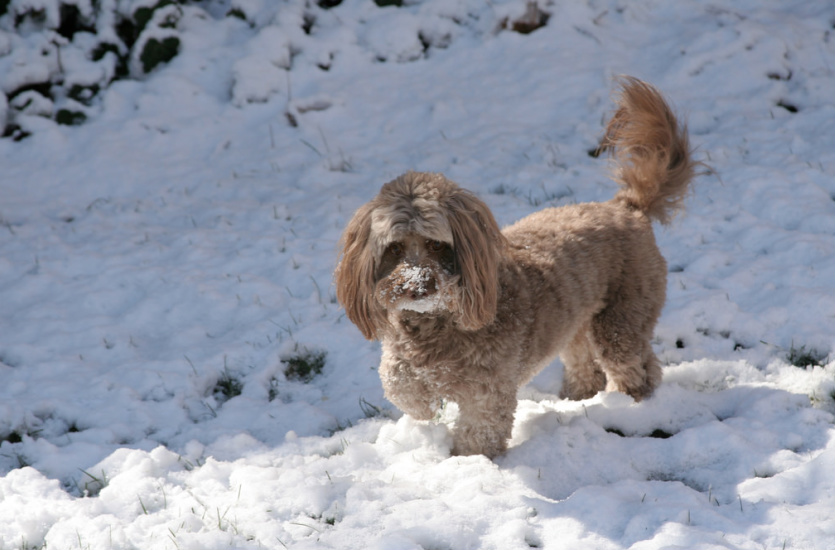
8. Green beans
Is your Doxiepoo getting a little pudgy around the stomach? Green beans have come to the rescue. High in fibre and low in calories, they will help your dog lose weight. They are also crunchy and me an excellent treat.
9. Salmon
You may notice this rather expensive fish included in the list of ingredients in your dog food. And it’s not surprising why.
Salmon is high in omega-3 fatty acids, which is helpful for people and dogs with weight problems. This fish will provide your overweight dog with the vitamins it needs.
10. Sweet Potatoes
These make a hearty and healthy treat for you and your pet. A big plus of this root vegetable is that it is easily digestible. Give sweet potatoes to your Doxiepoo either steamed or baked. Remember not to season them.
11. Apples
Contrary to what you may have heard, you can get apples to your dog. You’ll already know that they are full of vitamin C and A.
What’s dangerous for dogs is the apple core. It contains the seeds which store cyanide. Remove it before giving the apple to your dog.
12. Oatmeal
Another ingredient found in many dog foods, which you can give to your pet on its own, is oatmeal. Besides being a source of dietary fibre, it has all the vitamins and minerals your pet needs as well.
Doxiepoo Grooming
Doxiepoos are moderate to high maintenance dogs. How much you will have to look after your Doxie’s coat depends on how much poodle coat it inherits. There is also difficulty posed by the Dachshund coat-type. Doxiepoos have hairs with varying levels of curl.
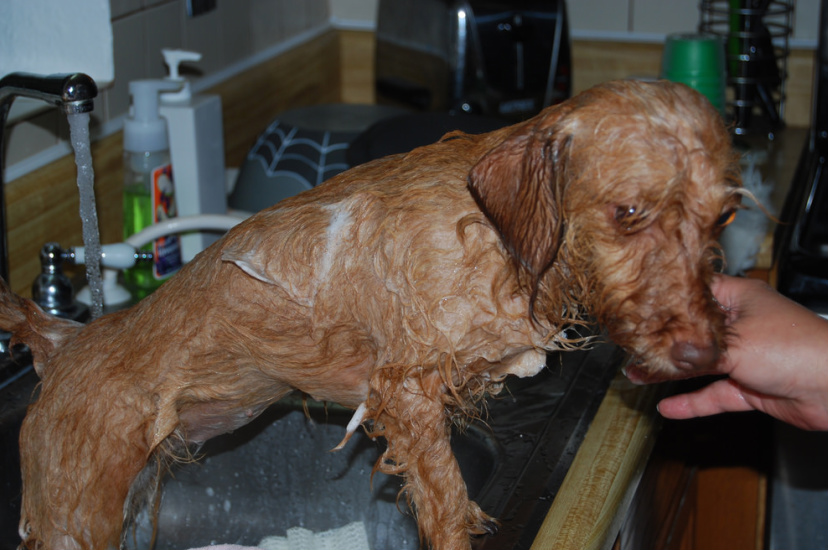
No matter the difficulty of maintaining the coat, you’ll need to brush your Doxiepoo at least twice weekly. Plan on giving it baths every 6 to 8 weeks. Of course, this depends on the climate around where you live and your dog’s activity level.
1. Gather Your Grooming Tools
To begin grooming your dog, gather your tools. These should include:
- • A bathtub for dogs
- • Styptic powder in case of injuries
- • Dog shampoo
- • A blow dryer
- • Clean cotton wads
- • Nose hair cutters
- • Hair clippers for dogs
- • Medicated ear solution
- • A showerhead
2. Remove mats and tangles
Mat removal can be a somewhat painful process for a dog. As you work through your dog’s hair, reassure It with pats and treats. If you have a detangling solution available, apply it to your dog’s coat as it will make the process easier. It also helps to use a unique tool that looks like a rake. Groomers call this a detangling brush.
3. Trimming before a bath
You may have to do this, depending on whether your Doxiepoo is long-haired. If it is, it will need trimming around the chest, paws, and belly. Use dog grooming clippers or regular scissors.
4. Brushing or combing
Again, this will take a little longer if your Doxie has long hair. You may want to use a tool known as the Furminator because the doxiepoo tends to have a lot of dander.
Remember to brush before bathing your Doxie or tangles may turn into mats.
5. Bathing
It’s difficult to predict if your dog will like bathing. Some dogs enjoy it, and we’ll ask you to spray them with water. Others just hate bath time. Wherever it is you choose to bathe your dog, make sure that you can control it.
Make sure that you place non-slip mats in your shower area or bathtub. If your Doxiepoo has allergies, ask your veterinarian to recommend an appropriate shampoo.
Work the shampoo into a good lather and massage it into the dog’s skin. Do this from the top of your dog’s head to its tail. Don’t forget to rub shampoo from the top to the bottom of your dog’s body as well. Doing all this makes it easier to remove tangles.
Always put cotton wool in your dog’s ears. Water may flow into the ear canals and cause an infection in the inner ears otherwise.
6. Drying
Then, it’s time to dry your dog. Use clean towels at first, then follow this with a blow dryer. Use a low or no heat setting.
7. Ear cleaning
As mentioned before, you should keep your dog’s ears dry at all times. A dog’s ears have a unique structure. Moisture encourages bacterial growth.
Put a few drops of the medicated ear solution at the base of the dog’s ears and massage it gently to remove excess debris. Flip the ear back and clean it carefully with a Q-tip.
8. Nail trimming
Ingrown nails, whether in humans or dogs, can cause acute infections. You’ll need to trim your dog’s nails regularly.
Your dog may resist nail cutting at first. To persuade It to cooperate, rub its paw gently. Do this a few times until the dog gets used to you touching it.
Once it does, start to cut its nails. Make sure that you don’t trim too much off, or you’ll risk cutting into the pinkish area known as the quick. As you can imagine, such a mistake will result in a significant flow of blood and a lot of pain for your pet. Have styptic powder available in case of an injury.
Doxiepoo Obedience Training
The Doxiepoo is an intelligent dog, though somewhat stubborn. You will need to spend some time asserting yourself over it and keeping it in line. Here are a few essential commands it must learn.
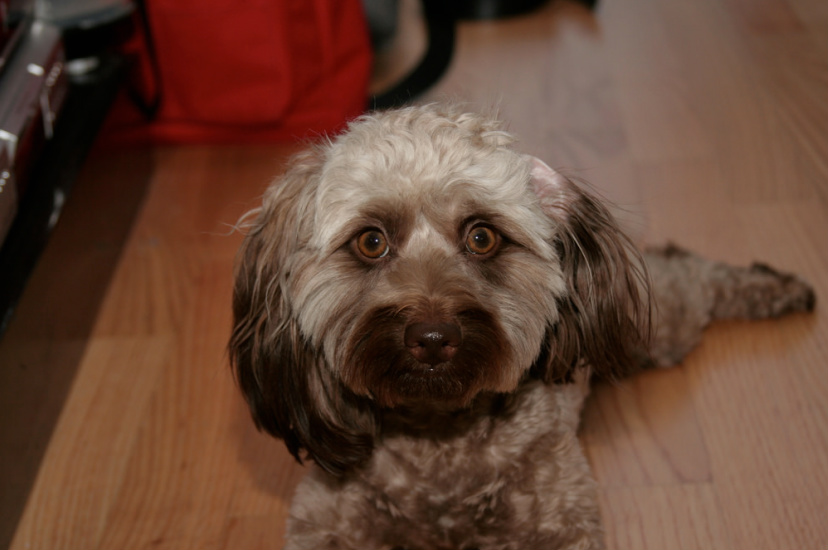
1. Sit
Every dog must learn to sit. You won’t want yours to be overpowering your guests.
To teach this command, hold a treat in front of your dog’s nose. Move your hand up above its head. Its eyes should follow the goodie. The gesture will also cause his behind to lower. Praise and treat it when it sits.
2. Come
This command keeps a dog out of Harm’s way. It prevents a feisty Doxiepoo from rushing out of the home and onto a busy road.
To begin teaching it how to come, leash it. Bend down to its level and say ‘come’, all the time pulling on the leash. When it finally arrives, reward and treat it. Once the dog gets used to this routine, remove the lead and keep using the command it comes to you voluntarily.
3. Down
This command is one of the most difficult to teach because it involves a level of submission. Your stubborn Doxiepoo may find it hard to respond to at first, but will eventually.
Hold an aromatic treat to your dog’s nose. Move your hand to the floor when it follows the smell.
To encourage its body to follow its head, move your hand along the floor. When it’s in the down position, give it the treat and praise it.
4. Stay
Another command that a restless dog may not necessarily respond to at first is ‘stay’. But you’ll need it to make your dog toe the line. It takes some patience to teach.
Get your dog to sit ( see above). Then, stretch out your palm in front of you and open it. Say ‘stay’.
Move backwards slowly. Reward your Doxie if it doesn’t follow you. Increase the number of steps you take back until your dog is familiar with the command.
In conclusion, you won’t regret welcoming the somewhat reserved but friendly Doxiepoo into your life. Being a Dachshund-Poodle hybrid, it has an exciting history and temperament. It may take some time to look after, but the grooming, training, and nutrition tips in this guide will serve you well.
